The biopharmaceutical industry is pioneering medical innovation, with therapeutic antibodies and Cell and Gene Therapies (CGTs) offering promising treatment options for various diseases.
These revolutionary therapies have their own set of challenges, however, most notably in terms of ensuring the purity and safety of final products. The presence of residual impurities represents one of the most critical issues facing manufacturers, demanding rigorous attention and cutting-edge solutions.
Throughout the Chemistry, Manufacturing, and Controls (CMC) production phase, different materials are essential for creating complex biotherapeutics. These include plasmid DNA, enzymes, host cell components, cytokines, antibodies, and antibiotics.
While central to the production process, these elements may persist as impurities, compromising the final product’s safety and efficacy.
Strict regulations require comprehensive testing and clearance of process-related residuals to ensure regulatory compliance and product quality. This need has prompted the development of several advanced detection methods, including ACROBiosystems’ resDetect™ system, which offers robust solutions for various types of impurities.
Host cell residual nucleic acid detection
Expression systems like HEK293/HEK293T cells and E. coli are widely used to produce viral and plasmid vectors in the production of CGTs. However, residual host cell DNA (resDNA) from these systems can persist, posing potential safety concerns, including carcinogenicity and infectious agents.
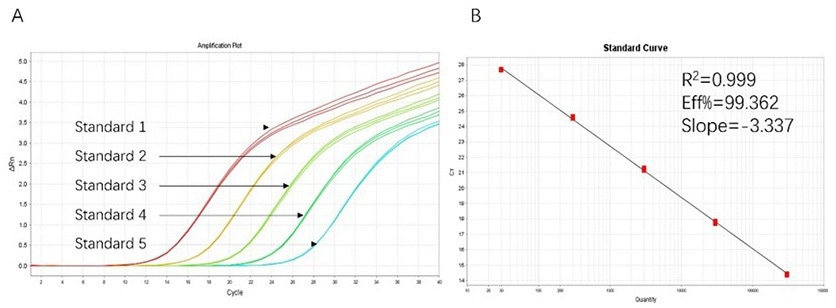
Figure 1. High sensitivity and broad dynamic range using the HEK293 resDNA Quantitation Kit. (A) Typical analysis results obtained with Standard 1 (300 pg/μL) to 5 (30 fg/μL). (B) The standard curve of the 10-fold dilution series. PCR efficiency should be 90-110 %. Image Credit: ACROBiosystems
Chinese Hamster Ovary (CHO) cells are central to therapeutic antibody production, but these can potentially release DNA fragments during manufacturing. DNA fragments pose comparable risks, and these must be carefully monitored and minimized to ensure the safety of monoclonal antibodies, bispecific antibodies, antibody-drug conjugates, and other popular products.
The Pichia pastoris expression system has grown in popularity throughout the field of recombinant protein production. This tool offers the distinct advantages of both prokaryotic and eukaryotic systems.
This specialized methylotrophic yeast is suitable for producing various biopharmaceuticals, providing affordable, high-level protein expression with eukaryotic post-translational modifications.
The system’s usefulness is highlighted by its use in FDA-approved products like Caplacizumab and Eptinezumab, and its capacity to achieve high-density fermentation and efficient protein expression has seen it become a widely respected tool throughout the biotechnology field. The Pichia pastoris expression system sees routine use in the production of diverse therapeutic proteins, including growth hormones, human albumin, and collagen.
The resDetect™ tool addresses these resDNA quality control challenges via a comprehensive range of highly sensitive residual host cell nucleic acid detection kits across numerous host cell types.
Plasmid DNA residue detection
Plasmid DNA is central to a wide range of gene therapy strategies, serving as a critical vector for gene delivery and expression. The potential for residual plasmid DNA in final therapeutic products represents both a regulatory challenge and a safety concern, however.
The presence of residual plasmid DNA may result in unintended gene expression, insertional mutagenesis, immunogenicity, and horizontal gene transfer of antibiotic resistance genes.
Thorough quantification and monitoring of residual plasmid DNA is required throughout the production process and in the final product in order to help mitigate these risks.
The high sensitivity and specificity of quantitative PCR (qPCR) have led to it becoming the gold standard for detection. Typical qPCR-based detection kits are able to offer wide dynamic ranges, detection limits as low as 1-10 copies, and multiplexing capabilities for the detection of multiple targets in parallel.
The FDA, EMA, and other regulatory bodies have established rigorous guidelines around residual DNA levels in gene therapy products, with a general threshold of 10 ng per dose generally enforced throughout the guidance.
The resDetect™ Plasmid DNA Residual Detection Kits are compatible with various gene therapy products, including those utilizing viral vectors. These kits also offer wide-ranging monitoring capabilities throughout the production process.
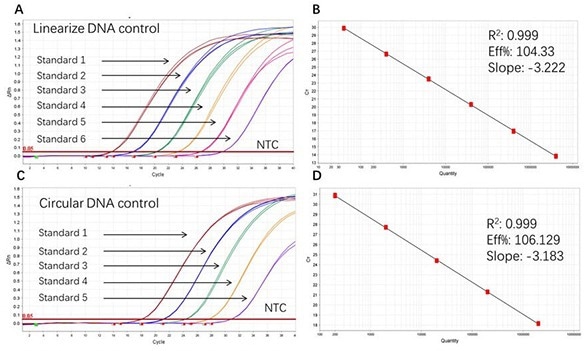
Figure 2. High sensitivity and broad dynamic range using the Plasmid resDNA Quantitation Kit. (A) Typical analysis results of obtained with Linearize DNA control Standard 1 (4×106 copies/µL) to 6 (4×10 copies/µL). (B) The standard curve of the Linearize DNA control 10-fold dilution series. PCR efficiency should be 90-110 %. (C) Typical analysis results of obtained with Circular DNA control Standard 1 (2×106 copies/µL) to 5 (2×102copies/µL). (D) The standard curve of the Circular DNA control 10-fold dilution series. PCR efficiency should be 90-110 %. Image Credit: ACROBiosystems
Viral oncogene residue detection
Cell lines like HEK293 and HEK293T are widely used in the production of viral vectors for gene therapies due to their efficient production of high-titer viral vectors.
These cell lines include oncogenes and viral sequences that may persist in final therapeutic products, however, posing substantial safety risks. It is, therefore, essential that viral oncogene residues be detected in order to ensure the safety and efficacy of gene therapy products.
If present, these residues can result in genomic instability, oncogenicity, and regulatory non-compliance. A number of detection methodologies have been developed to address these concerns.
Quantitative PCR (qPCR)-based platforms like the highly specific and sensitive resDetect™ kits facilitate the detection of E1A and SV40LTA DNA residues in CGT production.
These kits offer a robust quantitative detection limit of 40 copies/μL and the ability to complete an experimental protocol within 4 hours, making quality control both rapid and efficient.
The FDA and a number of other regulatory bodies have already established stringent guidelines around gene therapy product manufacturers’ responsibilities for the detection and control of residual viral oncogenes.
Manufacturers are required to validate detection methods and meet strict safety testing and compliance standards in order to keep residual viral oncogenes within acceptable limits and mitigate oncogenic risks in final therapeutic products.
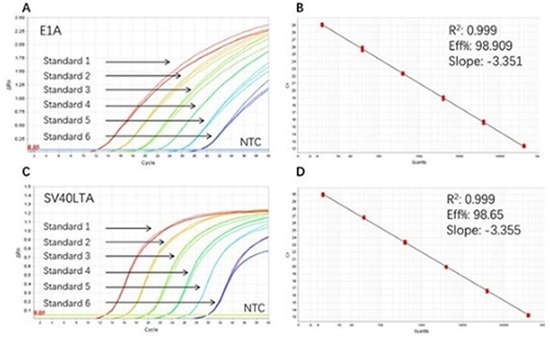
Figure 3. High sensitivity and broad dynamic range using the E1A&SV40LTA resDNA Quantitative Kit. (A) Typical analysis results of obtained with E1A DNA Control Standard 1 (4×106 copies/µL) to 6 (4×10 copies/µL). (B) The standard curve of the E1A DNA Control 10-fold dilution series. PCR efficiency should be 90-110 %. (C) Typical analysis results of obtained with SV40LTA DNA Control Standard 1 (4×106 copies/µL) to 6 (4×10 copies/µL). (D) The standard curve of the SV40LTA DNA controls 10-fold dilution series. PCR efficiency should be 90-110 %. Image Credit: ACROBiosystems
Enzyme residue detection
As the CGT field evolves, the detection and quality control of residual enzymes such as CRISPR/Cas proteins and nucleases (DNases and RNases) have rapidly become key quality control measures.
These enzymes are central to various CGT production stages, but they can pose a major risk if they are present in the final product. There is a risk of residual nucleases degrading therapeutic nucleic acids, which in turn compromises gene therapies’ integrity. The presence of CRISPR/Cas proteins may prompt off-target genetic modifications as well as triggering an undesirable immune responses in patients.
Quantitative PCR (qPCR)-based platforms like the resDetect™ kits offer an ideal means of addressing these challenges. These kits enable the highly sensitive and specific detection of residual enzymes via rapid protocols generally completed in just a few hours.
The speed and high sensitivity of these assays enable efficient quality control throughout the CGT production process and ensure compliance with strict regulatory requirements. Their specificity also facilitates the tailored detection of specific enzymes, such as RNases, DNases, and Cas proteins.
The EMA, FDA, and other regulatory agencies have set out guidelines for detecting and controlling process-related impurities, including enzyme residues.
It is important that manufacturers establish and justify acceptable levels of residual enzymes in their products. They are also required to validate their removal and detection processes, as well as provide comprehensive control strategy documentation.
These measures are key to ensuring product safety and efficacy and are also central to adhering to regulatory requirements in the fast-evolving field of cell and gene therapy.

Figure 4. DNase Activity Assay Kit (Fluorescence) (Cat. No. ASE-A002) and RNase Activity Assay Kit (Fluorescence) (Cat. No. ASE-A001) were used to detect nuclease residues in the same sample. No significant cross-reactivity or interference was observed. Image Credit: ACROBiosystems
Cytokine and antibody residue detection
The immune cell therapy field is also changing and evolving, a process that has seen the detection and control of residual antibodies and cytokines employed in manufacturing processes become critical quality control measures.
Interleukins (IL-2, IL-15, and IL-7) and anti-CD3/CD28 antibodies are important enablers of cell proliferation and differentiation during production. Their presence in the final product can also result in notable risks to patients, including altered therapeutic efficacy, unwelcome immune responses, and regulatory non-compliance.
Novel detection methodologies, including highly specific ELISA tests, mass spectrometry techniques, and multiplex bead-based assays, have been developed to address these challenges.
The resDetect™ platform from ACROBiosystems features an array of comprehensive assay kits designed explicitly for cell therapy products. These kits ensure compatibility with complex biological matrices and high sensitivity and specificity. These tools are critical for ensuring precise detection during CMC process quality control and maintaining regulatory compliance and product safety.
As the field continues to evolve, new trends emerge, including the integration of real-time, in-line monitoring, increased automation of detection methods, and the development of multi-analyte assays.
Manufacturers continue to prioritize rigorous cytokine and antibody residue detection, improving their quality control processes, minimizing risks to patients, and delivering more effective, safer cell therapy products.
Not only is this focus on residue detection an important regulatory requirement, it is also a key factor in advancing the potential of immune cell therapies to treat various diseases.
Antibiotic residue detection
Antibiotic residues must be detected and controlled in cell and gene therapy (CGT) products because this is key to ensuring their safety and efficacy.
Antibiotics like gentamicin and kanamycin are frequently utilized in cell culture processes throughout CGT manufacturing.
However, antibiotic residues in the final product can pose substantial risks to patients, including nephrotoxicity, allergic reactions, and ototoxicity. Their presence can also contribute to antimicrobial resistance.
Regulatory bodies like the FDA and EMA emphasize the need for minimal antibiotic residues in final products, particularly in the case of β-lactam antibiotics like penicillin, which can trigger severe allergic reactions in patients.
The advanced detection kits offered by the resDetect™ platform afford manufacturers an ideal means of ensuring product efficacy, safety, and regulatory compliance. The resDetect™ platform features a range of highly sensitive and specific antibiotic residue detection kits specifically designed for CGT manufacturing.
These user-friendly kits require minimal sample volumes and can detect low levels of residues to meet stringent regulatory requirements across various stages of CGT production workflows.
As the industry advances, the adoption of real-time monitoring, multi-analyte assays, rapid testing methods, and harmonized standards will be central to the production of increasingly sophisticated gene and cell therapies.
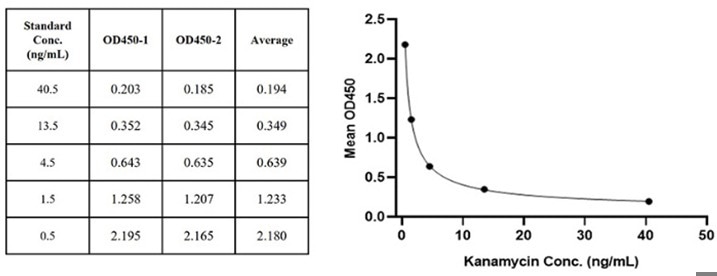
Figure 5. For each experiment, a standard curve needs to be set for each micro-plate, and the specific OD value may vary depending on different laboratories, testers, or equipment. The following example data is for reference only. (Cat. No. RES-A004). Image Credit: ACROBiosystems
Conclusion
The effective detection and control of residual impurities is essential if the safety and efficacy of biopharmaceutical products are to be ensured.
ACROBiosystems’ resDetect™ solutions represent a reliable, specific, sensitive, and thoroughly validated means of monitoring different residual impurities throughout CMC manufacturing processes.
The resDetect™ kits enable precise monitoring and control of these impurities, helping to safeguard patient well-being and improve confidence in the integrity of biopharmaceutical products.
Acknowledgments
Produced from materials originally authored by ACROBiosystems.
About ACROBiosystems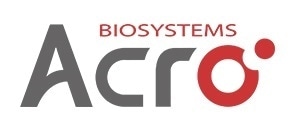
ACROBiosystems is a cornerstone enterprise of the pharmaceutical and biotechnology industries. Their mission is to help overcome challenges with innovative tools and solutions from discovery to the clinic. They supply life science tools designed to be used in discovery research and scalable to the clinical phase and beyond. By consistently adapting to new regulatory challenges and guidelines, ACROBiosystems delivers solutions, whether it comes through recombinant proteins, antibodies, assay kits, GMP-grade reagents, or custom services. ACROBiosystems empower scientists and engineers dedicated towards innovation to simplify and accelerate the development of new, better, and more affordable medicine.
Sponsored Content Policy: News-Medical.net publishes articles and related content that may be derived from sources where we have existing commercial relationships, provided such content adds value to the core editorial ethos of News-Medical.Net which is to educate and inform site visitors interested in medical research, science, medical devices and treatments.